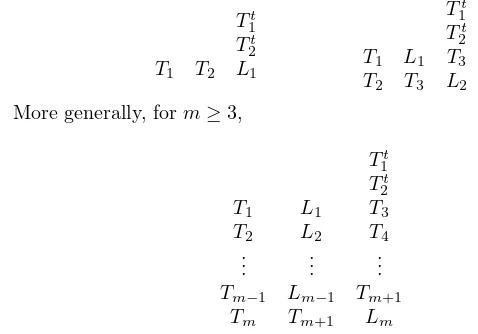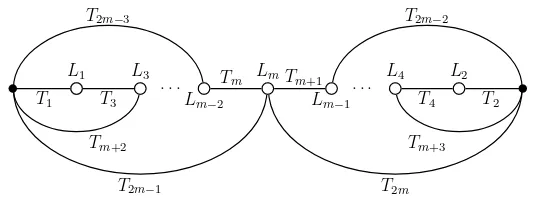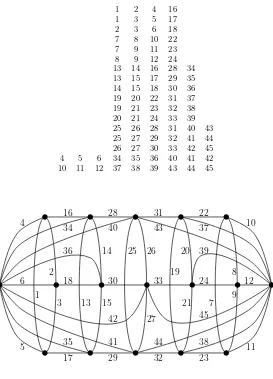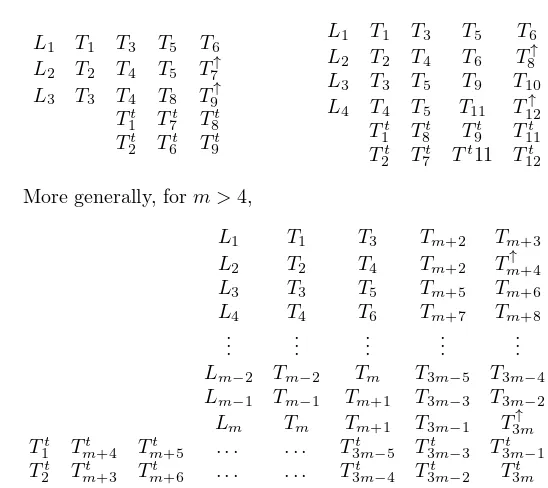Vol. 20, No. 2 (2014), pp. 95–110.
ANTIMAGIC LABELING OF GENERALIZED SAUSAGE
GRAPHS
Oudone Phanalasy
School of Mathematical and Physical Sciences University of Newcastle, Australia
and
Department of Mathematics National University of Laos, Laos
Abstract. Anantimagic labeling of a graph withqedges is a bijection from the set of edges to the set of positive integers{1,2, . . . , q}such that all vertex weights are pairwise distinct, where thevertex weightof a vertex is the sum of the labels of all the edges incident with that vertex. A graph isantimagicif it has an antimagic labeling. In this paper we construct antimagic labeling for the family of generalized sausage graphs.
Key words: Antimagic labeling, generalized sausage graph.
Abstrak.Sebuahpelabelan anti-ajaibdari sebuah graf denganqsisi adalah sebuah bijeksi dari himpunan sisi-sisi pada himpunan bilangan bulat positif{1,2, . . . , q} sedemikian sehingga semua bobot simpul berbeda per-pasangan, dimanabobot sim-pul dari sebuah simpul adalah jumlah dari label semua sisi yang bersesuaian dengan simpul. Sebuah graf adalahanti-ajaib jika dia mempunyai sebuah pelabelan anti-ajaib. Dalam paper ini akan dikonstruksi pelabelan anti-ajaib untuk keluarga graf sosis tergeneralisasi.
Kata kunci: Pelabelan anti-ajaib, graf sosis tergeneralisasi
1. Introduction
All graphs in this paper are finite, simple, undirected and connected, unless stated otherwise. In 1990, Hartsfield and Ringel [5] introduced the concept of an antimagic labeling of graph, that is, a vertex antimagic edge labeling. Anantimagic
2000 Mathematics Subject Classification: 05C78
labeling of a graphG= (V, E) is a bijectionf :E −→ {1,2, . . . ,|E|}such that all vertex weights are pairwise distinct, where the weight of a vertex vofG,wt(v), is the sum of the labels of all edges incident with the vertexv. A graphGis said to beantimagic if it has an antimagic labeling.
Hartsfield and Ringel [5] showed thatPn, Sn, Cn, Kn, Wn, andK2,n, forn≥3, are antimagic. They also conjectured that every connected graph, except K2, is antimagic. Subsequently, several families of graphs have been proved to be an-timagic, for example, see [1, 2, 3, 10]. Many other results concerning antimagic graphs are catalogued in [4]. Most recently, new families of antimagic graphs have been discovered by Phanalasy et al. [7], Miller et al. [6] and Rylands et al. [9]. However, the conjecture still remains open.
In the previous papers ([7, 9] for example), the results concerned regular and non regular graphs. Here we are extending the method to cover a class of almost regular graphs. We introduce a new family of graphs, called generalized sausage graphs, and we construct antimagic labeling for such family of graphs. The definition of this family of graphs is stated in Section 2.
Hereafter an edge labelinglof a graphGwill be described by an arrayL(not necessary rectangular), where all edge labels incident with a vertex are written in the same row. Since we are dealing with graphs, each label must occur exactly in two different rows.
2. Main Results
We first define a new family of graphs. Let Gbe a k-regular graph with p vertices and q edges. Thegeneralized sausage graph, denoted by S(G, m), is the graph obtained from the Cartesian product graphG×Pm,m≥1 (G×P1=G), by joining each vertex of each end of theG×Pmto a further vertex with an edge; and the two new vertices calledapexes. In particular, whenm= 1, each vertex of the graphGjoins to two vertices with two edges. Themixed generalized sausage graph, denoted by M S(G, m), is the graph obtained from the generalized sausage graph S(G, m), m ≥ 3, by joining each vertex of each copy of the ⌈m
2⌉copies of G on the left hand side to the left hand side apex, except the nearest copy to the apex, similarly, for the right hand side apex. The complete mixed generalized sausage graph, denoted byCM S(G, m) is the graph obtained from the generalized sausage graph by joining each vertex of each copy ofG, except the two nearest copies ofG to the apexes, to each apex with an edge, and each corresponding pair of vertices of the two nearest copies of Gto the apexes with an edge. The complete mixed generalized sausage graphCM S−(G, m) is the graph obtained fromCM S(G, m) by
Figure 1. Complete mixed generalized sausage graph CM S(C3,5)
graph in Figure 1 without A, while the graphs M S(C3,5) and S(C3,5) are the graphs in Figure 1 withoutA∪B and withoutA∪B∪C, respectively.
LetGbe any (connected or diconnected)k-regular graph withpvertices and qedges. We first choose any labeling ofG, that is, label the edges ofGby allocating integers 1,2, . . . q randomly. Then calculate the weights of the vertices and order the vertices so that wt(vi)≤wt(vi+1), 1≤i≤p−1. This ordering results in an array of edge labels ofG. It is considered as the original labeling and will be applied throughout the paper to produce antimagic labelings for graphs in the family of generalized sausage graphs.
Denote byTt the transpose of the array T. LetT = (1 2. . . p−1 p)t. We define thereverse of the arrayT as T↑= (p p−1. . .2 1)tand
Theorem 2.1. Let G6=nK1, n≥1, be any connected or disconnected k-regular graph. Then the generalized sausage graph S(G, m),m≥1, is antimagic.
Proof. Let Lj, 1 ≤j ≤ m, be the array of edge labels of the j-th copy of the graph G in S(G, m), m ≥1. Let Tl, 1≤ l ≤m+ 1, be the (p×1)-array of the edgesei, 1≤i≤p, whereei are the edges ofS(G, m),m≥1, that do not belong to any copy ofG. We construct the array Aof edge labels of S(G, m), m≥1, as follows.
. . .
Figure 2. Illustration of antimagic labeling of S(Kp, m), p ≥ 2, m≥2 andmeven
(1) Label the edgeei, 1≤i≤p, in the row iof the arrayTl, 1≤l≤m+ 1, with i+ (l−1)p, for 1≤l≤2; andi+ (l−1)p+ (l−2)q, for 3≤l≤m+ 1; (2) Replace the edge labels in the array Lj, 1≤j ≤m, with new labels obtained
by adding (j+ 1)p+ (j−1)qto each of the original edge labels; (3) Form the arrayAas shown below.
Form= 1,2,
More generally, form≥3,
Tt
The diagram in Figure 2 illustrates the antimagic labeling used here. By the construction of the arrayA, it is clear that the weight of each vertex (row) in the array is less than the weight of the vertex (row) below.
Case 2: G6=Kp, p≥1
(1) Replace the edge labels in the array Lj, 1≤j ≤m, with new labels obtained by adding (j−1)(p+q) to each of the original edge labels;
(2) Label the edgeei, 1≤i≤p, in the row iof the arrayTl, 1≤l≤m+ 1, with i+ (l−1)p+lq, for 1≤l≤m; andi+ (l−1)p+mq, forl=m+ 1;
(3) Form the arrayAinto two cases as shown below (two separate cases).
By the construction of the arrayA, it is clear that the weight of each vertex (row) is less than the weight of the vertex (row) below, except the weight of the last row of the subarrayL1T1T2and the weight of the rowTt
1 andT2tthat needs to be verified. This we do in 3 subcases.
Letwt(rf) be the weight of the rowrf.
Subcase 2.1.1: G= 2K2 (p= 4, q= 2 andk= 1)
We havewt(rp) =wt(T1t) = 18. However, by swapping the edge labels 7 and 10, then all weights of vertices are pairwise distinct.
Subcase 2.1.2: p=q= 4 and k= 2
It is simple to check thatwt(rp) = 27, wt(T1t) = 26 andwt(T2t) = 42.
Subcase 2.1.3: p, q >4,k >1
Since the largest possible edge labels of the last row in the array L1 are q−(k−1), q−(k−2), . . . , q−1 andq, hence we havewt(rp)≤(3p+k+2)q−
k(k−1) 2 < 3p+ (k+ 2)q < p(p2+1)+pq=wt(Tt
1). It is obvious thatwt(T1t)< wt(T2t).
Subcase 2.2: m≥2 Form= 2,
L1 T1 T2 T1 L2 T3 Tt 2 Tt 3
More generally, form≥3,
L1 T1 T2
T1 L2 T3
..
. ... ... Tm−2 Lm−1 Tm Tm−1 Lm Tm+1
Tt m Tt
m+1
By the construction of the arrayA, it is clear that the weight of each vertex (row) in the array is less than the weight of the vertex (row) below, except the weights of the last row in the subarrayTm−1LmTm+1and the rowTmt that need to be verified.
Letef,g be the edge label in the rowf and the columngin the arrayA. We have the largest possible edge labels in the last row (that is the row rmp) of the arrayLm and the rowTmt as shown below.
rmp: . . . (q−1) + (m−1)(p+q) q+ (m−1)(p+q) (m+ 1)p+mq Tt
We have emp,p−2+emp,p−1+emp,p ≤(3m−1)p+ 3mq−1 ≤3mp+ 3mq−3 = emp+1,p−2+emp+1,p−1+emp+1,p. Sinceemp,g< emp+1,g (in case there is noemp,g, we assumeemp,g= 0), 1≤g≤p−2 andp≥2, thereforewt(rmp)< wt(Tmt).
When the arrayLj, 1≤j≤m, is removed from the construction given in the proof of Case 1 of Theorem 2.1, the sausage graph degenerates into a path and so gives an alternative proof of the path being antimagic. The path has been proved to be antimagic originally in [5, 8].
Corollary 2.2. The generalized sausage graph S(K1, m) =Pm+2, m≥1, is
an-timagic.
Corollary 2.3. The generalized sausage graph S(nK1, m), m≥1 and n≥2, is
antimagic.
Proof. Forn= 2,S(2K1, m) is a circleC2m+2. It has been proved to be antimagic in [5, 8].
We next prove it for n ≥ 3. We first label the edges of the path Pm+2 as shown in the diagram in Figure 3. We label that the edge ei, 1≤i ≤m+ 1, of Pm+2 labels withi. This ensures that the weights of the vertices with degree 2 are pairwise distinct. To build the graphS(nK1, m) we usencopies ofPm+2. LetLj, 1 ≤ j ≤n, be the array of j-th copy of Pm+2, where the weights of the vertices with degree 2 are in the ascending order. We construct the array Aof edge labels ofS(nK1, m),m≥1 andn≥2, as follows.
(1) Replace the labeli of the edge ei in the array Lj, 1≤ j ≤ n, by adding (j−1)(m+ 1) to each of the original edge labels;
(2) Form the arrayAas shown below.
L′
1 L′
2 .. . L′
n A1 A2
whereL′
j, 1≤j≤n, is the array of the edge labels of the vertices of degree 2 ofjth-copy ofPm+2,A1= (m m+ (m+ 1) m+ 2(m+ 1). . . m+ (n− 1)(m+ 1)) andA2= (m+ 1 2(m+ 1) 3(m+ 1). . . n(m+ 1)).
We skip details of the proof whenn≥3 andm= 1. For the casen≥3 and m= 2, we only need a small change from the case ofn= 3 andm= 2 by swapping the labels 1 and 2; and the rest of the proof is skipped here since it is similar to the following case.
. . .
. . . 1 m−3m−1m+ 1 m−4
m−2
m
Figure 3. Illustration of a labeling of the pathPm+2,m≥1
of the vertex (row) below, except the weight of the last four rows that need to be verified.
Let rnm−1 and rnm be the last two rows of the subarray L′n. We have wt(rnm−1) = m+ (n−1)(m+ 1) + (m−2) + (n−1)(m+ 1) = 2(n+ 1)m−4,
wt(rnm) = n(m+ 1) + (m−1) + (n−1)(m+ 1) = 2n(m+ 1)−2, wt(A1) = nm+n(n−1)(2m+1) andwt(A2) =n(n+1)(2m+1).
Forn= 3, we havewt(rnm−1) = 6m+ 2,wt(rnm) = 6m+ 4,wt(A1) = 6m+ 3 andwt(A2) = 6m+ 6.
Forn≥4, we havewt(A1)−wt(rnm) = n
2m−3nm+n2−5n+4
2 >0. Therefore, wt(rnm−1)< wt(rnm)< wt(A1)< wt(A2).
We extend Theorem 2.1 to more general cases in the following theorems and corollaries.
Theorem 2.4. Let G6=nK1, n≥1, be any connected or disconnected k-regular graph. Then the mixed generalized sausage graph M S(G, m),m≥3, is antimagic.
Proof. LetLj, 1≤j≤m, be the array of edge labels of thej-th copy of the graph G in M S(G, m), m ≥3. We construct the array A of edge labels of M S(G, m), m≥3, as follows.
Case 1: m≥3 andmodd
LetTl, 1≤l≤2m, be the (p×1)-array of the edgesei, 1≤i≤p, whereei are the edges ofM S(G, m),m≥3, that do not belong to any copy of G.
Subcase 1.1: m= 3
First considerKp and then other graphs.
Subcase 1.1.1: G=Kp,p≥2
(1) Label the edgesei, 1 ≤i≤p, in the row iof the array Tl, 1 ≤l ≤2m, with i+ (l−1)p;
(2) Replace the edge labels in the array Lj, 1≤j ≤m, with new labels obtained by adding 2mp+ (j−1)qto each of the original edge labels;
(3) Form the arrayAas shown below.
Tt 1 T3t Tt
By the construction of the arrayA, it is clear that the weight of each vertex (row) in the array is less than the weight of the vertex (row) below, except possibly for some special cases below.
Letwt(rf) be the weight of the rowrf.
(a) Tt
2T4tand the first row ofT3T5L1
Since the least possible edge labels (that yield the least possible weight) of the vertex in the arrayL1are 1+6p,2+6p, . . . , k+6p, hencewt(r3)>(1+2p)+ (1+4p)+(1+6p)+(2+6p)+· · ·+(k+6p) = 6p2+p2−p
2 +2>5p
2+p=wt(Tt 2T4t). (b) Last row ofT4T6L2 and the first row ofT1T2T5T6L3
Letr2m+2 andr2m+3 be the last row of the arrayT4T6L2 and the first row of the array T1T2T5T6L3, respectively. We have the edge labels of the rows r2m+2 andr2m+3 as shown below.
r2m+2: 4p 6p . . .
r2m+3: 1 1 +p 1 + 4p 1 + 5p . . .
Since 4p+ 6p= 10p <10p+ 4 = 1 + (1 +p) + (1 + 4p) + (1 + 5p) and all edge labels in the arrayL2 are less than the least possible edge label in the array L3, hencewt(r2m+2)< wt(r2m+3).
Subcase 1.1.2: G6=Kp,p≥1
(1) Replace the edge labels in the array Lj, 1≤j ≤m, with new labels obtained by adding (j−1)qto each of the original edge labels;
(2) Label the edgesei, 1 ≤i≤p, in the row iof the array Tl, 1 ≤l ≤2m, with i+ (l−1)p+mq;
(3) Form the arrayAas shown below.
L1 T1 T3 L2 T2 T4 L3 T3 T4 T5 T6
Tt 1 T5t Tt
2 T6t
By the construction of the arrayA, it is clear that the weight of each vertex (row) in the array is less the weight of the vertex (row) below, except the weights of the last row of the subarray L3T3T4T5T6 and the row Tt
1T5t that need to be verified. Letr3mandr3m+1 be the last row of the subarrayL3T3T4T5T6 and the row Tt
1T5t, respectively. Since p≥k+ 2, we have the edge labels of the rows r3m and r3m+1 as shown below.
r3m: . . . 3p+ 3q 4p+ 3q 5p+ 3q 6p+ 3q r3m+1: . . . 5p+ 3q−3 5p+ 3q−2 5p+ 3q−1 5p+ 3q
. . .
Figure 4. Illustration of antimagic labeling ofM S(G, m),m >4 andmodd (3) Form the arrayAas shown below.
L1 T1 T3 The diagram in Figure 4 illustrates the antimagic labeling used here.
and the rest of the edge labels in the rowrmpis less than the edge label in the row r3m+1 of the corresponding column. Hence wt(rmp)< wt(rmp+1).
Case 2: m≥4 andmeven
LetTl, 1≤l≤2m−1, be the (p×1)-array of the edgesei, 1≤i≤p, where ei are the edges ofM S(G, m),m≥3, that do not belong to any copy of G.
(1) Replace the edge labels in the array Lj, 1 ≤ j ≤ m, with new labels by adding (j−1)q to each of the original edge labels;
(2) Label the edgesei, 1≤i≤p, in the rowiof the arrayTl, 1≤l≤2m−1, withi+ (l−1)p+mq;
(3) Form the arrayAinto two cases as shown below.
Subcase 2.1: m= 4
L1 T1 T3 L2 T2 T4 L3 T3 T5 T6 L4 T4 T6 T7
Tt 1 T5t Tt
2 T7t
ForG=K2, we swap the labels 17 and 18 in the array T7.
Forq≥p, by the construction of the array A, it is clear that the weight of each vertex (row) is less than the weight of the vertex (row) below, except the last row of the subar rayL4T4T6T7and the row Tt
1T5tthat need to be verified.
Letef,g be the edge label in the rowf and the column g. Letr4p andr4p+1 be the last row of subarrayL4T4T6T7 and the rowTt
1T5t, respectively. We have the edge labels in the rowsr4p andr4p+1 as shown below.
r4p: . . . 6p+ 4q 7p+ 4q r4p+1: 1 + 4q . . . 5p+ 4q−1 5p+ 4q
. . .
Figure 5. Illustration of antimagic labeling ofM S(G, m),m >4 andmeven
The diagram in Figure 5 illustrates the antimagic labeling used here. By the construction of the arrayA, it is clear that the weight of each vertex (row) is less than the weight of the vertex (row) below, except the last row of the subarrayLmTmT2m−2T2m−1 and the row T1tTmt+1. . . T2tm−8T2tm−6
(b) m≥8 andp= 2
It follows immediately from (b), hencewt(rmp)< wt(rmp+1).
We give an example for the construction in the proof of Theorem 2.4 (Sub-case 1.2) in Figure 6.
Corollary 2.5. The mixed generalized sausage graph M S(K1, m), m≥3, is an-timagic.
Proof. We divide the proof into three cases.
Case 1: m= 3
The same construction as the one given in the proof of Subcase 1.1.1 of The-orem 2.4 also works whenever the array Lj, 1≤j≤3, is removed.
Case 2: m≥4
Subcase 2.1: mis odd
The same construction as the one given in the proof of Subcase 1.2 of Theo-rem 2.4 also works whenever the arrayLj, 1≤j≤m, is removed.
Subcase 2.2: mis even
The same construction as the one given in the proof of Case 2 of Theorem 2.4 also works whenever the arrayLj, 1≤j≤m, is removed. Using this construction, whenm= 4 andm= 6, there are some weights are equal. However, we need only a small change by swapping the labels 5 and 6, then all vertex weights are pairwise distinct.
Corollary 2.6. The mixed generalized sausage graph M S(nK1, m), m ≥ 3 and
n≥2, is antimagic.
Proof. For m odd, the same constructions as the one given in the proof of Subcase 1.1.2 and Subcase 1.2 of Theorem 2.4 also work whenever the array Lj, 1≤j≤m, is removed.
Form= 4, the same construction as the one given in the proof of Subcase 2.1 of Theorem 2.4 also works whenever the arrayLj, 1≤j ≤m, is removed; except when n= 2, we need a small change by swapping 13 and 14, and whenn= 3 by swapping 20 and 21.
Form≥6 andmeven, the same construction as the one given in the proof of Case 2.2 of Theorem 2.4 also works whenever the arrayLj, 1≤j ≤m, is removed.
Recall the definition of the reverseT↑ from Section 2; we will use it in the
proofs of the following theorems and corollaries.
Theorem 2.7. Let G6=nK1, n≥1, be any connected or disconnected k-regular graph. Then the complete mixed generalized sausage graphCM S(G, m),m≥3, is antimagic.
. . .
Figure 7. Illustration of antimagic labeling ofCM S(G, m),m≥ 3 andm even
(1) Replace the edge labels in the array Lj, 1 ≤ j ≤ m, with new labels obtained by adding (j−1)(p+q) to each of the original edge labels; (2) Label the edgesei, 1≤i≤p, in the rowiof the arrayTl, 1≤l≤3m, with
i+ (l−1)p+lq, for 1≤l≤m, andi+ (l−1)p+mq, form+ 1≤l≤3m; (3) Form the arrayAas shown below.
Form= 3,4,
More generally, form >4,
L1 T1 T3 Tm+2 Tm+3
By the construction of the arrayA, it clear that the weight of each vertex (row) is less than the weight of the vertex (row) below, except some special cases that need to be verified.
We skip details for the casem= 3 and next verify for the casem≥4. Letef,g be the label at the rowf and the columng in the arrayA.
(a) Rowsrp andrp+1
We have the edge labels of rowsrp andrp+1 as shown.
rp: . . . (m+ 2)p+mq (m+ 3)p+mq rp+1: . . . 1 + (m+ 1)p+mq (m+ 4)p+mq
Sinceep,mp−1+ep,mp= (2m+ 5)p+ 2mq <(2m+ 5)p+ 2mq+ 1, for allp andq, andep,g< ep+1,g, for 1≤g≤mp−2, hencewt(rp)< wt(rp+1). (b) Rowsr(m−1)p andr(m−1)p+1
We havee(m−1)p,mp−2+e(m−1)p,mp = (4m−1)p+ 2mq <4mp+ 2mq+ 1 = e(m−1)p+1,mp−2+e(m−1)p+1,mp, for allp and q; ande(m−1)p,g < e(m−1)p+1,g, for 1≤g≤mp−3, andg=mp−1. Thenwt(r(m−1)p)< wt(r(m−1)p+1). (c) Rowsrmp andrmp+1
Sincem≥4 andp≥2, it is clear thatrmp< rmp+1. (d) Rowsrmp+1 andrmp+2
Let A and B be the sum of all the edge labels in subarrays Tt
1Tmt+4 and Tt
2Tmt+3, respectively. It is easy to check thatA < B and emp+1,g < emp+2,g, for 2p+ 1≤g≤mp. Hence wt(rmp+1)< wt(rmp+2).
The same construction as the one given in the proof of Theorem 2.7 also works when the arrayLj, 1≤j ≤m, is removed. We have
Corollary 2.8. The complete mixed generalized sausage graph CM S(nK1, m),
m≥3,n≥1, is antimagic.
See Section 2 for definition ofCM S−(G, m), then we have
Corollary 2.9. Let G6=nK1, n≥1, be any connected or disconnected k-regular graph. Then the complete mixed generalized sausage graph CM S−(G, m),m≥2,
is antimagic.
Proof. Ifm≥3, removeTm+2from the arrayAin the proof of Theorem 2.7 and replace the arrayTl withTl−1, form+ 3≤l≤3m.
Ifm= 2, we construct the arrayAas shown.
L1 T1 T2 T3 L2 T1 T4 T5↑
Tt 2 T4t Tt
3 T5t
For p ≥ 3, it is similar to (a) in the proof of Theorem 2.7 for checking wt(rp) < wt(rp+1). We next prove that wt(r2p)< wt(r2p+1). We have the edge labels ofr2p andwt(r2p+1) as shown.
r2p: . . . p+q 4p+ 3q 1 + 4p+ 3q r2p+1: . . . 4p+ 3q−2 4p+ 3q−1 4p+ 3q
Sincee2p,2p−2+e2p,2p−1+e2p,2p= 9p+ 7q+ 1<12p+ 9p−3 =e2p+1,2p−2+ e2p+1,2p−1 +e2p+1,2p and e2p,g < e2p+1,g, for 2p−k−2 ≤ g ≤ 2p−3, hence wt(r2p)< wt(r2p+1).
The same construction as the one given in Corollary 2.9 also works when the array Lj, 1≤j ≤m, is removed, except when m= 2 andn= 1, it needs a small change by swapping the labels 1 and 2. Then we have
Corollary 2.10. The complete mixed generalized sausage graphCM S−(nK1, m),
m≥2,n≥1, is antimagic.
References
[1] Alon, N., Kaplan, G., Lev, A., Roditty, Y. and Yuster, R., “Dense graphs are antimagic”,J. Graph Theory,47(4) (2004), 297–309.
[2] Baˇca, M. and Miller, M.,Super Edge-Antimagic Graphs: A Wealth of Problems and Some Solutions, BrownWalker Press, Boca Raton, Florida, USA, 2008.
[3] Baˇca, M., Lin, Y. and Semaniˇcov´a-Feˇnovˇcikov´a, A., “Note on super antimagicness of discon-nected graphs”,Int. J. Graphs and Comb.,6(1) (2009), 47–55.
[4] Gallian, J. A., “A Dynamic survey of graph labeling”,Electron. J. Combin.,19(♯DS6) (2012). [5] Hartsfield, N. and Ringel, G.,Pearls in graph theory: A comprehensive introduction,
Aca-demic Press Inc., Boston, MA, 1990.
[6] Miller, M., Phanalasy, O., Ryan, J. and Rylands, L., “Antimagicness of some families of generalized graphs”,Austral. J. Combin.53(2012), 179–190.
[7] Phanalasy, O., Miller, M., Rylands, L. and Lieby, P., “On a relationship between completely separating systems and antimagic labeling of regular graphs”,LNCS 6460(2011), 238–241. [8] Ryan, J., Phanalasy, O., Miller, M. and Rylands, L., “On antimagic labeling for generalized
web and flower graphs”,LNCS 6460(2011), 303–313.
[9] Rylands, L., Phanalasy, O., Ryan, J. and Miller, M., “An application of completely sepaprat-ing sysrtems to graph labelsepaprat-ing”,LNCS8288(2013), 376–387.





